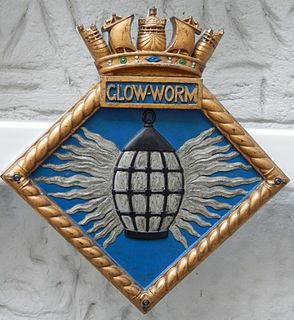Related Research Articles
Seven ships of the Royal Navy have been named Warspite. The origins of the name are unclear, although it is probably from the Elizabethan-era spelling of the word 'spite' – 'spight' – in part embodying contempt for the Navy's enemies, but which was also the common name for the green woodpecker, suggesting the 'Warspight' would poke holes in enemy ships' (wooden) hulls. Until 1919 a woodpecker was used as the ships' crest; the official badge was a cannon, although the woodpecker continued to be used on the ships' tompions or gun muzzle plugs. Warspite carries the most battle honours of any ship in the Royal Navy, with the sixth Warspite being awarded fifteen of them.
Eight ships of the Royal Navy have been named HMS Ardent, whilst another two were planned:
Seven ships of the British Royal Navy have been named HMS Orion, after the hunter Orion of Greek mythology:
Nine ships of the Royal Navy have been named HMS Grafton, while another one was planned:
Six Royal Navy ships have borne the name HMS Southampton. All were named after Southampton, a port on the south coast of England.
Three ships and one shore establishment of the British Royal Navy have been named HMS Collingwood, after Admiral Cuthbert Collingwood, 1st Baron Collingwood:

Three ships of the Royal Navy have borne the name HMS Glowworm after the insect, whilst two more were planned:
Seven ships of the Royal Navy have been named HMS Hecla, after the volcano Hekla in Iceland.
Three ships of the Royal Navy have been named HMS Adamant:

HMS Camellia was a Flower-class corvette that served in the Royal Navy.
Seven ships of the Royal Navy have been named HMS Orpheus. Orpheus was the magical father of songs in Greek mythology.
Four ships and two shore establishments of the Royal Navy have been named HMS Buzzard after the bird, the buzzard:
Nine ships and a number of shore establishments of the Royal Navy have been named HMS Pembroke.
Seven ships of the Royal Navy have been named HMS Melpomene after the Muse of Tragedy in ancient Greek mythology.
Three vessels of the British Royal Navy have been named HMS Nerissa:
Three ships of the Royal Navy have borne the name HMS Arabis, after the flower, the Arabis.
Four vessels of the Royal Navy have been named HMS Thunderbolt:
Three Royal Navy ships have been names HMS Snapdragon, after the flower:

HMS Crispin was a C-class destroyer of the Royal Navy built by J. Samuel White, Cowes between 1944 and 1946. She was originally to have been named HMS Craccher. She was sold to the Pakistan Navy in 1958 and renamed PNS Jahangir. She was scrapped in 1982.
Three ships of the Royal Navy have borne the name HMS Newark, after the town Newark-on-Trent:
References
- Colledge, J. J.; Warlow, Ben (2006) [1969]. Ships of the Royal Navy: The Complete Record of all Fighting Ships of the Royal Navy (Rev. ed.). London: Chatham Publishing. ISBN 978-1-86176-281-8.